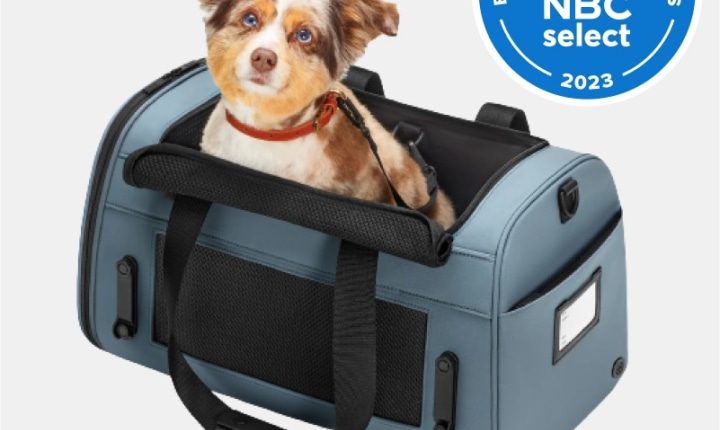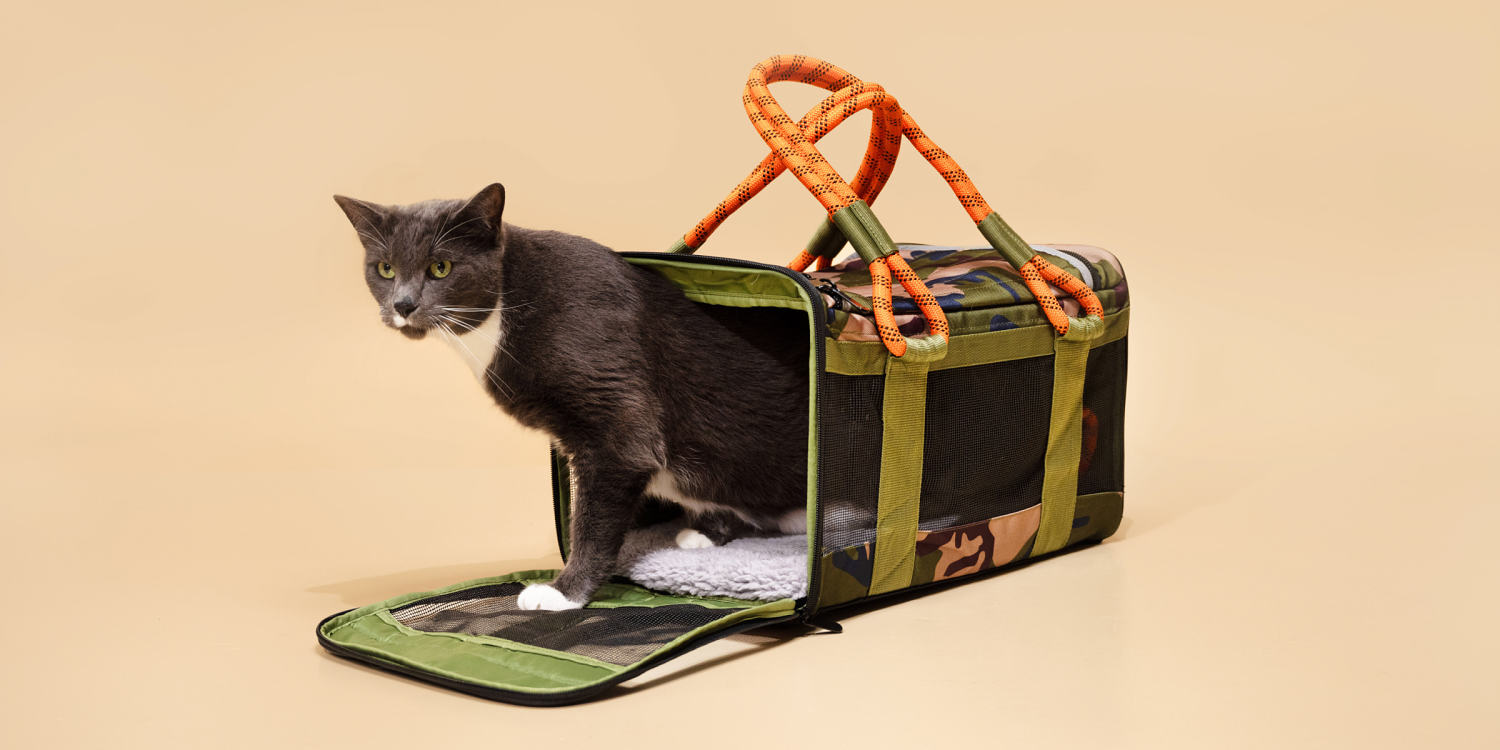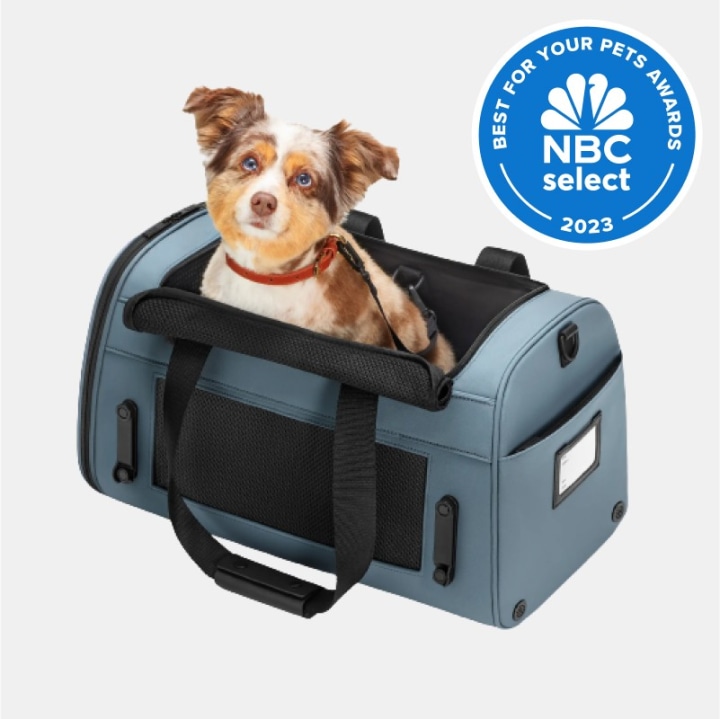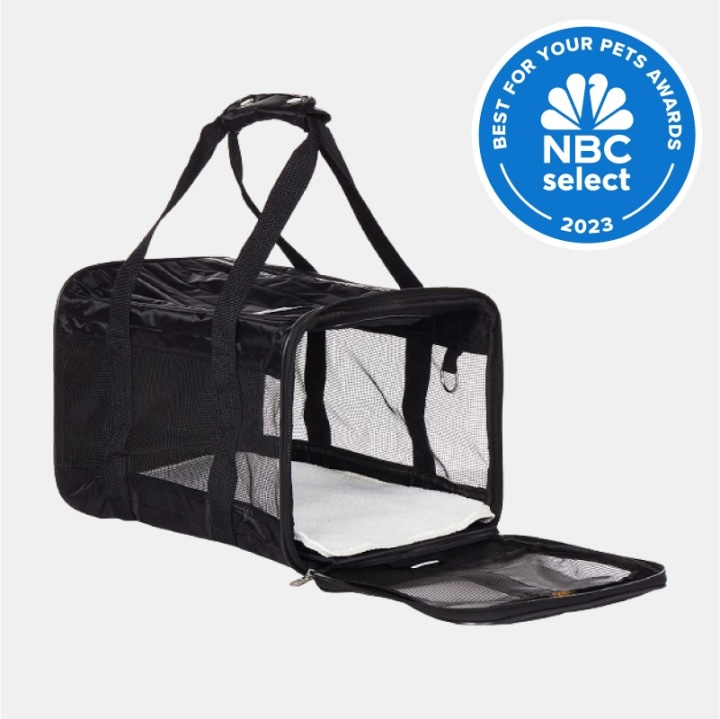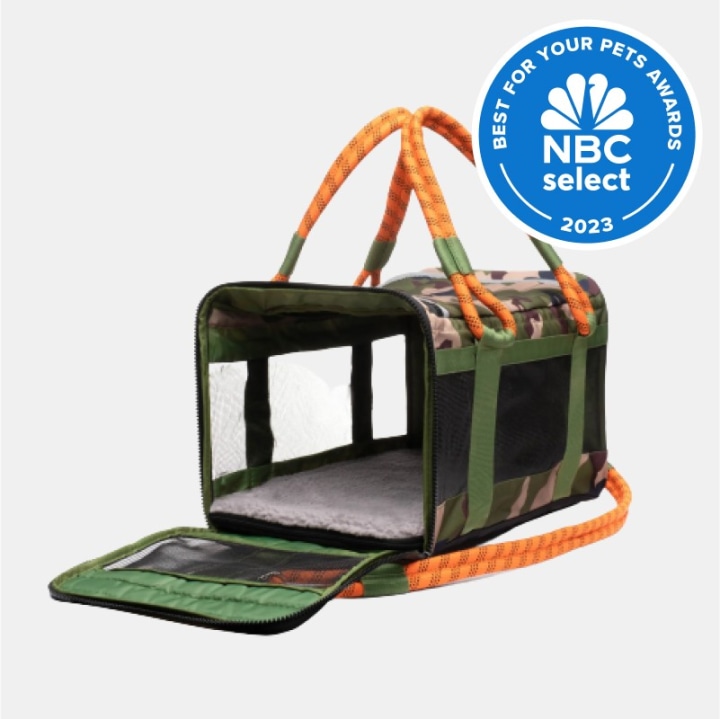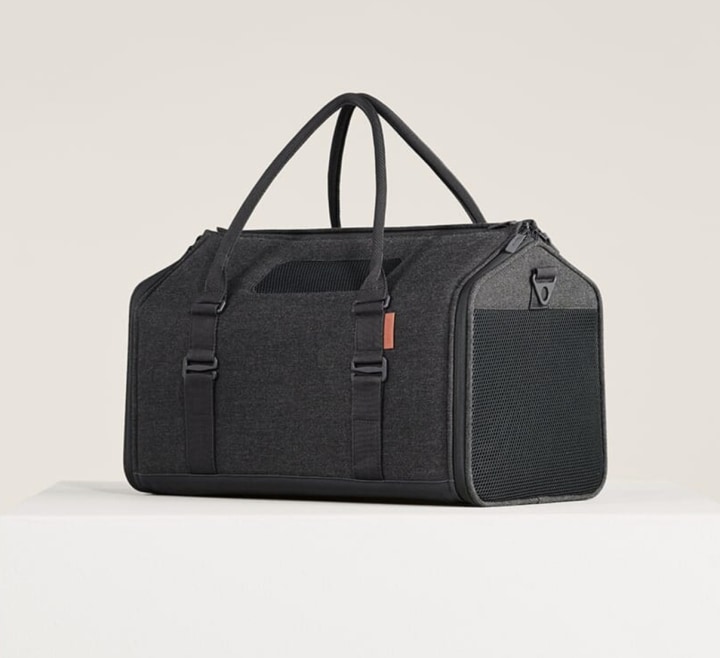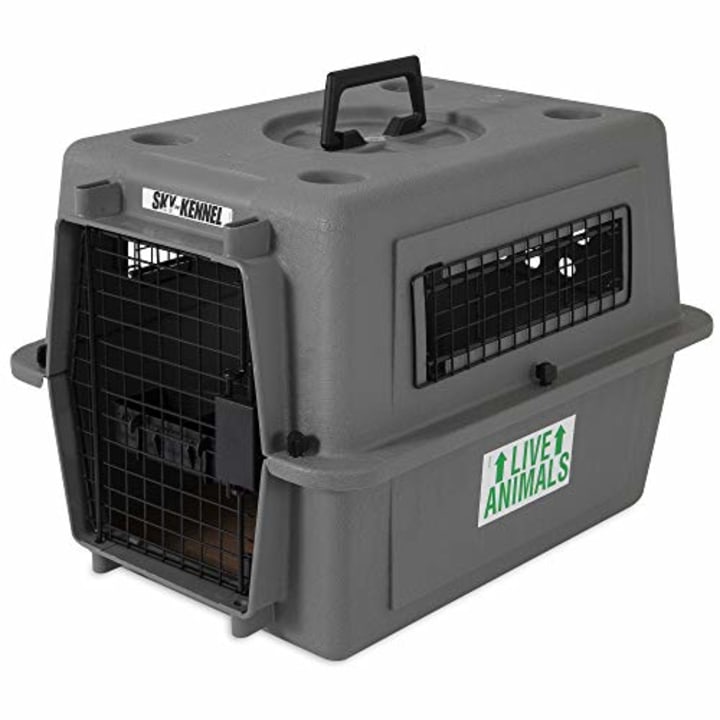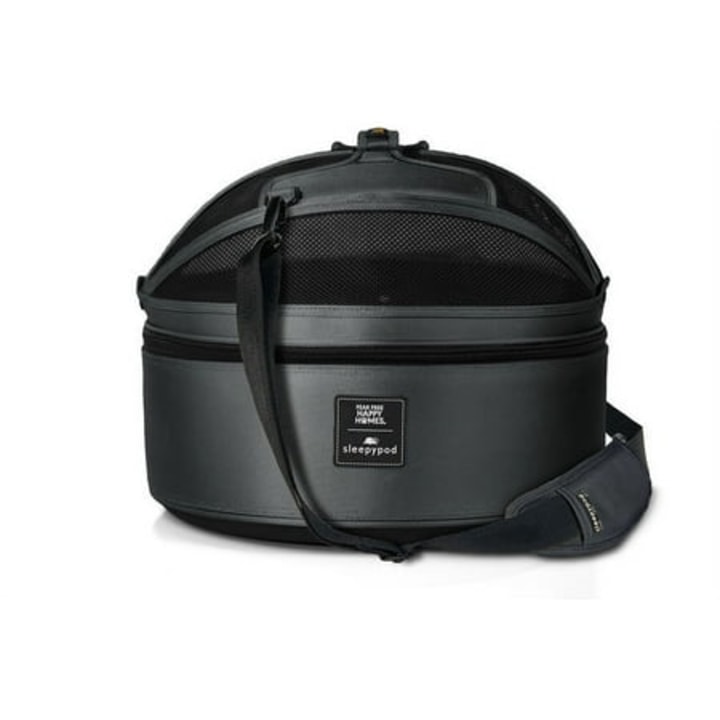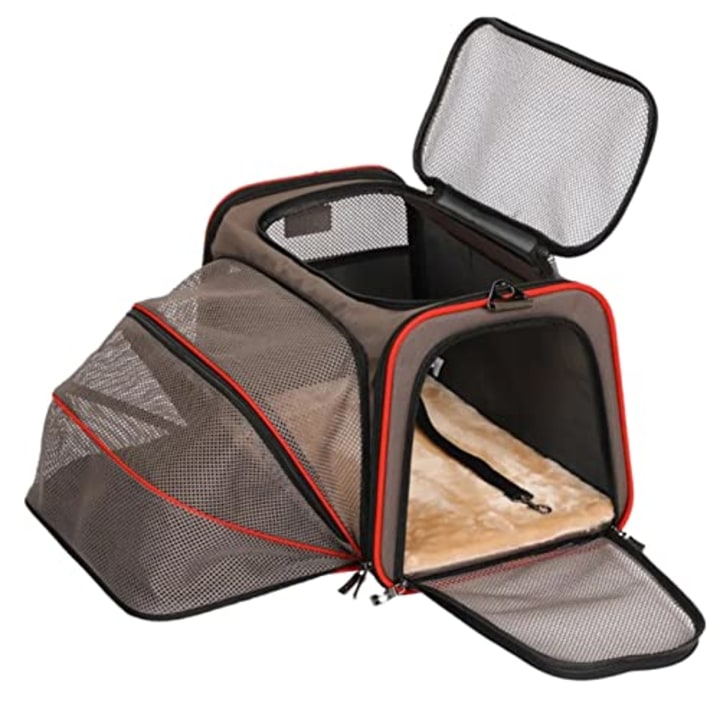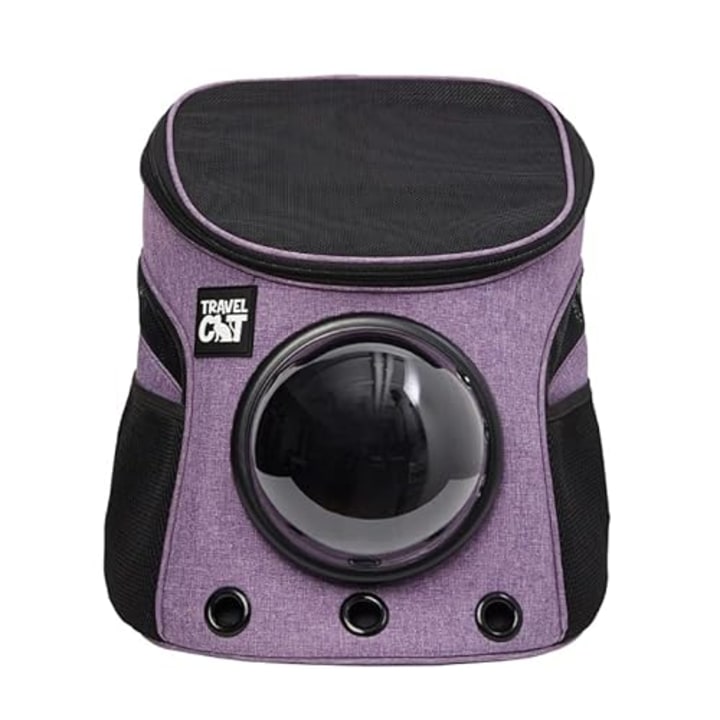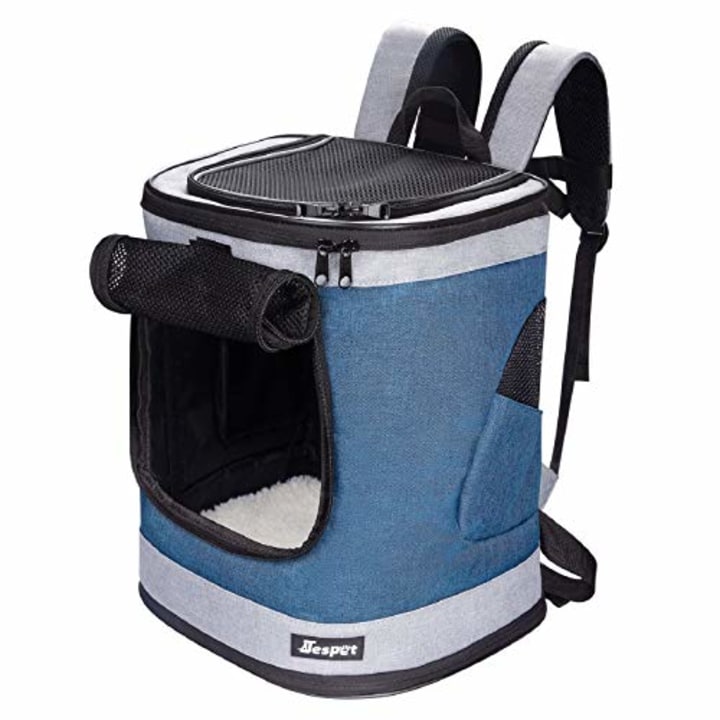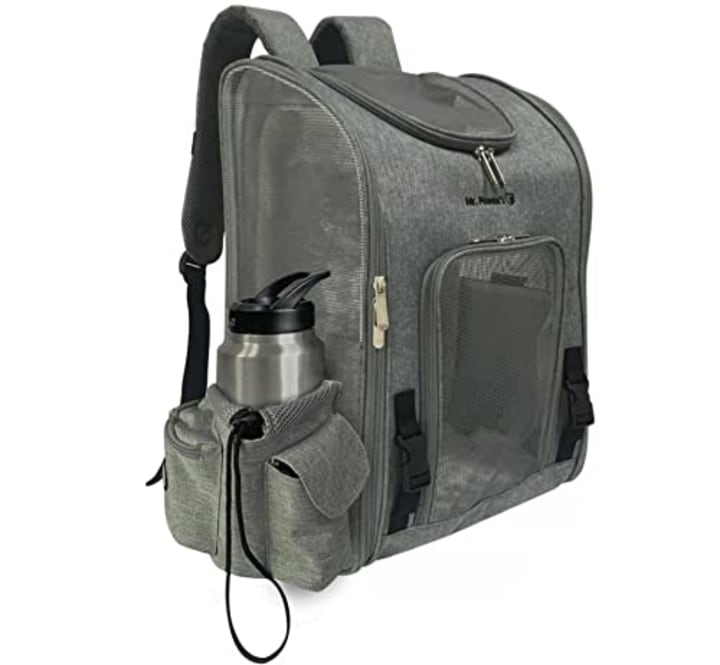Whether some cats like it or not, spending time inside a travel carrier is necessary for vet visits and family trips. Cat carriers run the gamut as far as size, style and build are concerned, so it’s important to think about what models your feline companion will be the safest and most comfortable in.
We consulted cat behaviorists, trainers and veterinarians for key factors to consider while shopping for one. They also shared tips for acclimating cats to their carriers, and what you should know about driving, flying and simply walking down the block with them.
SKIP AHEAD Best cat carriers | Best cat backpacks | How to help cats get used to their carriers
How we picked the best cat carriers and backpacks
- Mode of transportation and activity: How you’re traveling with your cat largely impacts what type of carrier you should purchase, our experts say. If you’re flying with your cat, for example, you’ll need to check your airline’s dimension requirements for in-cabin carriers (meaning those that fly with the passengers). But if you’re taking your cat in a car or on a train, there aren’t the same kinds of limitations, giving you more freedom in choosing a carrier.
- Size: To find the right size carrier for your cat, measure from the base of their tail to their snout and add a few inches — that’s how long the carrier should be, says Albert Colominas, a cat trainer and behaviorist who founded Outdoor Bengal, which offers cat training videos, gear and other online resources. To determine how tall the carrier should be, measure from the top of your cat’s shoulders to the floor and add a few inches. This ensures they can stand and sit up straight without crouching, he says.
- Weight limit: Most brands note the maximum weight their cat carrier supports to help you determine if it’s the right fit.
- Style: Most cat carriers look like tote bags or backpacks. Tote bag-style carriers offer cats more sprawling room, which is especially important for longer trips. Backpack-style carriers are usually more cramped, but if you’re walking a short distance, they’re easy to carry. Brands also make wheeled carriers, which you should try to stay away from, says Jennifer Van de Kieft, a certified advanced feline training and behavior professional who owns Cat Advocate, a feline behavior consulting company. They may seem convenient, but they’re less stable than options you hold, and may cause your cat to get bumped around while in transit. Cats appreciate being close to you when they’re in unfamiliar situations, so carrying them with hand or shoulder straps is preferred, she says.
- Opening: Standard cat carriers have a side opening, but if your cat fights you on going inside, you may find it easier to maneuver them through wider top openings.
- Hard-sided versus soft-sided: Hard-sided carriers are often made from plastic, and they act as durable, solid, protective shells for cats, says Colominas. Soft-sided carriers, on the other hand, are typically made from fabric like nylon and polyester, so they’re lightweight, soft and comfortable. Soft-sided carriers tend to be best for air travel or for walking short distances with your cat. Hard-sided options are the safest option for car travel and come in handy for aggressive cats who gnaw or claw at fabric. They’re also preferred for cats who suffer from motion sickness or have accidents in transit since plastic is easier to clean than fabric, says Colominas.
- Visibility: All carriers allow cats to see their surroundings, but some offer more visibility than others. Confident, curious cats might feel more at ease if they can watch what’s happening outside of their carrier — in this case, look for options with mesh or clear windows, says Colominas. But timid cats often find visibility overwhelming — in this case, look for options with limited windows. You can also cover a carrier with a blanket or sheet to occasionally decrease visibility, like if you’re walking through a crowded airport, says Van de Kieft.
- Storage: Just like traveling with kids, traveling with pets requires lots of snacks, toys and other accessories to keep them happy and comfortable. Rather than packing a separate bag, look for carriers with exterior pockets.
- Safety: If you want extra assurance that the cat carrier is safe for car travel specifically, look for those crash-tested by the Center for Pet Safety, a non-profit that conducts independent crash tests on cat and dog travel products. Also be aware that some carriers have a tether inside them with a clip on the end — attach it to your cat’s harness to prevent them from jumping out when you open a door. Van de Kieft does not recommend clipping it to a cat’s collar, as doing so limits their range of motion too much and could become unsafe.
The best cat carriers to shop
With expert guidance in mind, we rounded up a handful of cat carriers to consider across styles and sizes. They include Select Pet Award winners, other carriers we’ve tried and highly rated options. Airline-approved cat carriers and backpacks are also noted, which means they’re designed to fit under seats in most commercial airlines, according to the brands. But different airlines have different size requirements for in-cabin carriers, so be sure to check with the airline before bringing it to the airport.
The best cat carriers
Away The Pet Carrier
Away’s carrier — a Select Pet Award winner — has soft yet rigid sides that help the bag keeps its shape during and between uses, in my experience. It’s designed with a leather body and water-resistant nylon interior, making accidents easy to clean up if they happen. The carrier comes with a removable, washable plush sherpa bed cats can rest on, plus it’s built with a luggage sleeve, latches that can fasten it to a car seat belt and a removable name card. You can also choose to carry the bag by its handles or removable shoulder strap. Away’s carrier is certified by The Center for Pet Safety and it’s personalizable for an additional $35.
I love using this carrier for my cat Wanda. I appreciate the spacious exterior pocket, which holds her treats and a couple small toys, as well as my phone and wallet. There’s even a dedicated clip for my keys. The carrier also has a side pocket with water-resistant lining and drainage holes in case you put a collapsible water bowl inside. There’s mesh panels on three sides of the carrier, and one side has an added retractable privacy screen — I keep it up when we’re in the car or at the vet so Wanda can see her surroundings, but roll it down while walking through busy New York City streets to shield her from some of the activity.
Size (LxWxH) : 18.7 x 10.8 x 10.75 in. | Opening: Top and side | Weight limit: Up to 18 lbs. | Airline approved: Yes
Sherpa Original Deluxe Pet Carrier
The majority of cat parents on Select’s team own Sherpa’s carrier, and they all love its simplicity and functionality. The Select Pet Award winner also has a flexible spring wire frame and mesh side panels. The interior of the base is covered in water-resistant material and a removable, machine-washable liner, giving cats a soft, cozy place to rest. You can hold the carrier by its padded handles or detachable shoulder strap. There’s also an exterior storage pocket and a luggage sleeve that you can weave a seat belt through during car rides.
Size (LxWxH): 17 x 11 x 10.5 in. | Opening: Top and side | Weight limit: Up to 16 lbs. | Airline approved: Yes
Roverlund Out-Of-Office Pet Carrier
Roverlund’s carrier comes in two sizes — small and large — the latter of which is a great option for traveling with big cats, says Rebecca Rodriguez, NBC Select editorial projects manager. She uses it to take her 16-pound cat Enzo to the vet, and is impressed by its sturdy structure, despite being a soft-sided carrier. The bag has three mesh side panels and a leak-resistant base lined with polyester. It also comes with a machine-washable, fleece-lined bed. You can store your cat’s travel accessories in the bag’s rear pocket, and Rodriguez finds its rope handles and shoulder strap are comfortable and supportive. There are also reflective details, making it more visible in the early morning or late evening.
Size (LxWxH) : 17 x 11 x 10.5 in. (small), 19 x 11.75 x 11.5 in. (large) | Opening: Top and side | Weight limit: Up to 15 lbs. (small), up to 25 lbs. (large) | Airline approved: Yes (must remove rear pocket insert before flying)
Tuft & Paw Porto Cat Carrier
Tuft & Paw’s Porto carrier doubles as a cozy bed, thanks to its zippered walls. You can unzip one of them to form the base of the bed while the other three stay upright, which makes my cat Wanda feel safe and secure while sleeping. In fact, she naps in it so much that I leave this carrier out 24/7 to make coaxing her inside for travel easier.
The carrier is made from water-resistant canvas and has multiple mesh windows. It’s also designed with a luggage sleeve, handles and a detachable shoulder strap, as well as a pocket to store travel essentials. Plus, it comes with a machine-washable faux shearling pad.
Size (LxWxH) : 18.75 x 10.5 x 11.25 in. | Opening: Top and side | Weight limit: Up to 30 lbs. | Airline approved: Yes
Petmate Sky Kennel Pet Carrier
Because they’re likely to be the most protective in an accident, a rectangular, hard-sided carrier is best for car travel, says Dr. Marcia Landefeld, a veterinarian and owner of the Feline Veterinary Hospital in Port Washington, New York. Its rigid top and bottom pieces are typically held together via metal nuts and bolts, and Landefeld likes options with a metal door that swings outward and tightly locks in place, preventing escape.
Petmate’s Sky Kennel Pet Carrier offers all of these features, and it has a 4.4-star rating from 6,748 reviews on Amazon. Cats can see outside all four walls, and it comes with clip-on bowls and ID stickers. Petmate’s carrier has a top handle, but Landefeld suggests putting your arms underneath its base and holding it like a sack of potatoes to keep your cat more stable.
Size (LxWxH) : 21 x 16 x 15 in. | Opening: Side | Weight limit: Up to 15 lbs. | Airline approved: No
Sleepypod Pet Carrier
To prevent going into a carrier, some cats hold their legs out and stiffen them, making it very difficult — if not impossible — to finagle them through a narrow opening. You might have an easier time getting finicky cats inside dome-shaped carriers, which typically have very wide top openings, says Landefeld.
The Sleepypod Pet Carrier, certified by The Center for Pet Safety, has a mesh dome top that zips onto a rigid nylon base lined with water-resistant polyester. The carrier comes with machine-washable plush bedding and to get cats in and out, you can either completely unzip the mesh dome from the base or zip the middle of the dome open. The carrier also comes with a removable padded shoulder strap, or you can carry it by its top handle. Plus, it has built-in seatbelt straps to secure it to car seats.
Size: 17 in. diameter, 13.5 in. height | Opening: Top | Weight limit: Up to 15 lbs. | Airline approved: No
Petsfit Expandable Carrier
One side of this cat carrier is designed with an expandable mesh panel, giving your cat extra sprawling room if you’re in the waiting room at the vet or sitting at the gate before boarding a plane. Once it’s time to move, you can fold the mesh panel so it’s flat against the carrier and zip it shut. The carrier — which has a 4.6-star average rating from 1,918 reviews on Amazon — has a solid wire structure, multiple mesh windows and a removable, machine-washable plush bed. Its base is made from water-resistant material, and you can store travel essentials in a side storage pocket. The carrier is also built with a luggage sleeve and handles, plus a removable, adjustable shoulder strap.
Size (LxWxH) : 17 x 11 x 11 in., expands to 20 x 17 x 11 in. | Opening: Top and side | Weight limit: Up to 13 lbs. | Airline approved: Yes
The best cat backpacks
The Fat Cat Mini Backpack Carrier
Select production coordinator Kelsey Fredricks uses this backpack to show her 11.5-pound cat Kiwi the outside world. She finds it very protective while taking him on walks to see squirrels and pigeons, as well as to the vet. There’s mesh on the tops and sides of the carrier, plus a bubble window cats can look out of. You can also swap out the bubble window for a screen to make the front of the backpack flatter, which you may have to do if you’re flying with it. There are multiple storage pockets on the backpack’s exterior, as well as adjustable shoulder, chest straps and a removable, machine-washable plush pad.
Size (LxWxH) : 20 x 7 x 19 in. | Opening: Top | Weight limit: Up to 15 lbs. | Airline approved: Yes
Jespet Backpack Carrier
Since her 16-pound cat Sammy is big, NBC commerce photo editor Kara Birnbaum finds it easier to carry him in a backpack compared to a tote. She says this model is comfortable since it has adjustable straps and padded walls that keep the backpack stable while she’s walking. The carrier is designed with multiple mesh windows and comes with a removable, machine-washable soft fleece pad. You can also lay the backpack down or sit it up when you take it off. It’s built with exterior storage pockets, too.
Size (LxWxH) : 13 x 12 x 17 in. | Opening: Top and front | Weight limit: Up to 16 lbs. | Airline approved: Yes
Mr. Peanuts Aspen Series Backpack Pet Carrier
This cat backpack is a lifesaver when I fly with Wanda, which is why I’ve taken it on five flights in the past two years. In addition to the top and front openings, both sides of the backpack unzip, providing extra wide doors I put Wanda through when she’s being difficult about going in the more narrow openings. I lay the backpack down when I have to put it under the seat on the plane and it gives Wanda plenty of space to stretch out and rest comfortably. The backpack is also tall enough that she can sit up straight when I stand it up.
Mr. Peanuts’ backpack comes with a removable, machine-washable fleece pad and is built with a luggage sleeve, seat belt attachment and multiple mesh windows. Its padded shoulder straps are comfortable for me to wear while walking through the airport, and there’s a hidden pocket on the back of the carrier that’s large enough to store a 13-inch laptop. The sides of the backpack also have pockets to store pet essentials or a water bottle.
Size (LxWxH) : 14 x 8 x 17.5 in. | Opening: Top, front and sides | Weight limit: Up to 16 lbs. | Airline approved: Yes
How to help cats get used to their carriers
Once you find the right carrier for your cat, it’s time to help them get used to spending time in it. Here are some of the best ways to do so, according to experts.
Make sure the carrier is clean
If a carrier has been in storage for a while, clean it before introducing it to your cat, says Van de Kieft. Make sure it doesn’t smell strange and is free of dust, dirt and bugs — all things that could deter your cat from getting inside.
Leave the carrier out in your home
It’s important to make your cat’s carrier a fun place to be, which starts with leaving it out in your home so they have constant access to it, says Van de Kieft. Cats are super smart, and if you exclusively bring the carrier out when it’s time to go to the vet, for example, they’ll associate negative experiences with it. Instead, let cats explore the carrier on their own and make it inviting by adding a soft blanket or one of their favorite toys.
Finding a place to leave your cat’s carrier out may take some trial and error. Some cats ignore their carrier in one room but jump right into it in another, says Van de Kieft. Regardless of where it ends up, it’s best to elevate the carrier on a table or chair, she says. Cats are biologically programmed to like heights — in the wild, it’s how they’d spot predators and find food. Thus, elevating their carrier makes it more attractive, says Van de Kieft.
Spray it with calming pheromones
Pheromones are chemical substances animals naturally release into their environments, and certain types have calming, comforting effects, says Van de Kieft. Feliway makes a spray that mimics the natural facial pheromone cats mark their territory with when they feel safe and secure, and this smell can cause them to feel less stressed, according to the brand. Van de Kieft and Landefeld recommend spraying your cat’s carrier with Feliway’s spray to help them understand that it’s a safe place to be. I’ve used this spray for about two years with my cat, and it seems to encourage her to explore her carrier at home, plus take the edge off when we’re in transit.
Praise your cat when they’re inside the carrier
“The best way to carrier train your cat is to reinforce every time they’re inside it,” says Van de Kieft. Give them a treat every time they’re inside it, verbally praise them by talking to them and pet them, for example. This creates positive associations with the carrier and signals that it’s a happy, safe place to be.
Play soothing music
Some artists make music that’s specifically composed to be calming for cats, and playing it can help reduce stress around certain situations, like being put into its carrier. Van de Kieft recommends David Teie’s Music for Cats, some of which you can stream for free through his website.
Buy a new carrier
“If your cat absolutely hates its carrier, the easiest thing to do might be to just get a completely different one,” says Van de Kieft. Cats who have a negative experience with a carrier may never go near it again, or panic at the sight of it. In this case, starting fresh with a new carrier may be your best option.
Meet our experts
At Select, we work with experts who have specialized knowledge and authority based on relevant training and/or experience. We also take steps to ensure that all expert advice and recommendations are made independently and with no undisclosed financial conflicts of interest.
- Albert Colominas is a cat trainer and behaviorist. He is the founder of Outdoor Bengal, which offers cat training videos and other online resources, as well as cat training gear. He and his cat Mia have traveled across the world together since 2020.
- Jennifer Van de Kieft is a certified advanced feline training and behavior professional. She owns Cat Advocate, a feline behavior consulting company. She works with cat guardians to give them the strategies, tools and knowledge needed to address their cat’s behavior issues. Van de Kieft provides virtual consultations throughout the United States.
- Dr. Marcia Landefeld is a veterinarian and owner of the Feline Veterinary Hospital in Port Washington, New York. She joined the staff of the Feline Veterinary Hospital in 1983 and has been the owner since 1998.
Why trust Select?
Zoe Malin is an associate updates editor at Select who writes about pet products, including dog nail clippers and accessories to keep your dog cool. For this article, she interviewed three experts about how to shop for cat carriers and rounded up highly options, in addition to expert picks and Select staff recommendations.
Catch up on Select’s in-depth coverage of personal finance, tech and tools, wellness and more, and follow us on Facebook, Instagram, Twitter and TikTok to stay up to date.
Source: | This article originally belongs to Nbcnews.com
